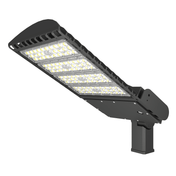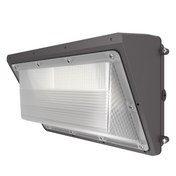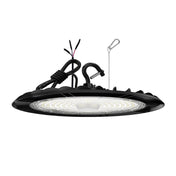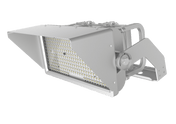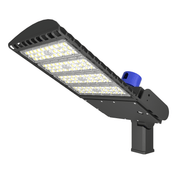In the field of industrial outdoor lighting, stability, durability, and energy efficiency are key priorities. With their excellent environmental adaptability, long service life, and low energy consumption, industrial LED area lights have become the lighting of choice for locations such as factories, warehouses, logistics parks, mining terminals, and large industrial roads. Compared to traditional industrial lighting sources, industrial LED area lights offer breakthroughs in extreme environmental tolerance, operational and maintenance cost control, and lighting safety, providing reliable support for safe production and cost reduction and efficiency improvement for industrial enterprises.
I. Core Advantages: A Lighting Solution for Essential Industrial Applications
1. Ultra-Durable, Suitable for Extreme Industrial Environments
Industrial LED area lights feature an industrial-grade protection design, typically achieving an IP67 rating or higher, with some products offering an IP68 rating for specialized applications. They effectively withstand dust, sewage immersion, and high-pressure water jets. Their housings are typically constructed from a one-piece die-cast aluminum alloy with a tempered glass cover, achieving an impact resistance of IK08-IK10, capable of withstanding external forces such as vibration from industrial equipment and collisions with materials. The lamps maintain stable operation in extreme temperatures ranging from -40°C to +60°C, fully meeting the lighting needs of high-temperature or extremely cold industrial environments, such as those found in metallurgy, mining, and chemical industries.
2. High efficiency and energy saving, reducing industrial electricity costs
Industrial scenarios require long lighting hours and a large number of lamps, resulting in a high energy consumption cost. Industrial LED area lights generally have a luminous efficacy of 140-180 lm/W, saving over 75% energy compared to traditional 1000W metal halide lamps. For example, a large machinery manufacturing plant replaced 200 1000W metal halide lamps with 200W industrial LED area lights, operating 16 hours per day. This saved approximately 43,200 yuan in electricity bills per month, exceeding 510,000 yuan annually, with a payback period of just 8-12 months. Some products also support intelligent dimming, automatically adjusting brightness based on production shifts and natural light intensity, further unlocking energy-saving potential.
3. Safe and Stable, Ensuring Industrial Production Lighting
Industrial LED area lights utilize a low-voltage DC drive, resulting in flicker-free and glare-free lighting. With a color rendering index (Ra ≥ 85), they clearly reproduce equipment details, material colors, and the operating environment, reducing safety accidents caused by visual errors. The lights start up without delay and reach rated brightness instantly, eliminating the dimming transition period associated with traditional light sources. Furthermore, the LED light source contains no harmful substances such as mercury and lead, meeting industrial environmental requirements. There is no risk of heavy metal contamination after end-of-life, aligning with the company's green production philosophy.
II. Key Technologies: Core Guarantee Supporting Industrial-Grade Performance
1. Industrial-Grade Light Source and Driver Technology
Utilizing high-reliability LED chips, such as those from Taiwan Epistar and Bridgelux, the chip junction temperature is controlled below 85°C, resulting in a low light decay rate of ≤3% after 10,000 hours. The driver adopts an isolated design and features multiple protections, including overvoltage, overcurrent, short-circuit, and lightning protection (surge rating up to 4kV). It accepts a wide AC85-265V input voltage and is compatible with power grid fluctuations in various industrial plants, ensuring stable operation of the lamp in complex power supply environments.
2. Efficient Heat Dissipation and Anti-Corrosion Technology
Designed for high-temperature industrial environments, the heat dissipation structure utilizes a heat pipe + vapor chamber composite structure, combined with a nano-thermal conductive coating, improving heat dissipation efficiency by over 30% compared to traditional aluminum alloy heat sinks. The housing is dual-treated with anodizing and electrostatic spraying, achieving a salt spray corrosion resistance rating of over 1,000 hours. It can withstand corrosive gases found in locations such as coastal docks and chemical parks, significantly extending the lamp's service life in harsh environments.
3. Intelligent Industrial IoT Integration
This high-end industrial LED area light supports Industrial Internet of Things (IIoT) integration, connecting to factory MES systems and intelligent operation and maintenance platforms via wireless communication protocols such as LoRa and NB-IoT. This enables real-time lamp status monitoring, active fault alarms, and remote on/off dimming. Operations and maintenance personnel can view each lamp's power, temperature, brightness, and other parameters through the backend system, accurately locating fault points, reducing on-site inspection workload, and improving O&M efficiency.
III. Applicable Scenarios: Covering All Industrial Outdoor Lighting Needs
- Factory and Workshop Peripheries: For protection against equipment vibration and dust, 50-150W industrial LED area lights with a wide beam angle (120°-150°) provide uniform illumination of factory roads and loading and unloading areas, ensuring safe nighttime operations.
- Warehouse and Logistics Parks: For high requirements on light intensity and color rendering, 80-200W lamps meet the lighting needs of racking areas and transport aisles. Motion sensor control enables energy-saving lighting in unmanned areas.
- Mines and Ports: For impact and corrosion resistance, 200-400W high-power lamps with an anti-glare design can withstand the harsh environments of mine faces and port loading and unloading platforms, ensuring clear visibility for heavy machinery.
Large industrial parking lots require long-term, stable lighting. 30-60W lamps with IP67 protection can provide full parking lot illumination while reducing energy consumption during off-peak hours through intelligent dimming.
IV. Key Points: Selection Guide for Industrial Users
When purchasing industrial LED area lights, key considerations include: first, environmental compatibility. Choose products with the appropriate protection level and anti-corrosion process based on the temperature, humidity, and corrosiveness of the location. Second, performance parameters. Prioritize products with a luminous efficacy of ≥150 lm/W, a color rendering index ≥80, and a lifespan of ≥50,000 hours. Third, safety certifications. Products must meet industrial lighting safety standards such as CE, UL, and GB7000.1. Fourth, intelligent functionality. Choose products that support IoT access and sensor control based on operational and maintenance needs to reduce ongoing management costs.
Summary
Industrial LED area lights prioritize durability and energy efficiency. Leveraging industrial-grade technological innovations, they are perfectly suited for a variety of complex industrial outdoor scenarios. It not only helps industrial enterprises reduce their huge electricity bills and operation and maintenance costs, but also improves lighting safety and stability, helping enterprises achieve green production and efficient operations. As the process of industrial intelligence accelerates, industrial LED floodlights will further integrate with the Internet of Things and big data, becoming a core component of the industrial smart lighting ecosystem.




